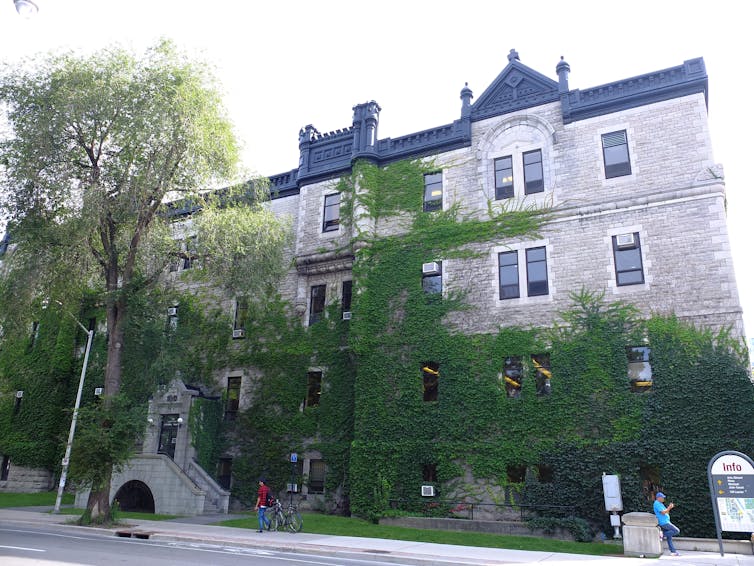
How do universities and colleges decide who to admit? Given the earnings advantage of a post-secondary degree both globally and in Canada, this is an important social mobility question.
While the answer varies from one institution to the next, most focus on education criteria like exam scores and grades.
However, Canada’s new intake cap on study permit applications puts increased pressure on Canadian institutions to also consider immigration criteria when admitting international undergraduate students.
This is just the latest example of immigration’s growing influence on the societal roles of Canadian universities and colleges. Yet those who value public higher education need to vigilantly monitor the implications of such shifts.
This includes the expanding role of for-profit educational technology (EdTech) companies in the privatization and commercialization of higher education.
Companies marketing application services
Before the cap, international applicants’ immigration-related factors, such as citizenship, were considered indirectly. For example, Canada’s federal international education strategies emphasized the importance of diversifying international student source countries to minimize financial risk.
However, EdTech companies now market services which rank individual applicants’ purported likelihood of study permit approval. According to an international education trade magazine, several institutions in Ontario use such services.
This challenges the fundamental principles of post-secondary education access and could impact the diversity of Canadian campuses.

Tech platforms increasingly influential
I research the recruitment of international students as immigrants. Higher education’s strategic international enrolment efforts play a big role in the initial selection process. Technology-enabled recruitment and immigration support platforms have become increasingly influential over the past decade, particularly since the COVID-19 pandemic.
Often referred to as “agent aggregators,” these platforms use a range of technologies, sometimes including artificial intelligence, to promise profit — for both themselves and their post-secondary institution clients — by improving international student recruitment and retention.
These platforms are part of a growth in third parties involved in international student recruitment that remains largely unregulated.
Admission patterns shifting
Until recently, schools first evaluated international post-secondary applicants’ education credentials to decide whether to issue an acceptance letter. Only after this step, when applying to the federal government for a study permit, were immigration credentials assessed.
In other words, institutions admitted international students, then the federal government admitted them to Canada.
Given provincial governments’ gradual disinvestment from public higher education and the increasing reliance on international student tuition, schools issued more and more acceptance letters to international students.
“Unsustainable” growth, especially at colleges, eventually made life difficult for Immigration, Refugees and Citizenship Canada (IRCC), which processed a record 863,197 new study permit applications in 2023.

New ‘provincial attestation letter’
In January 2024, the federal government responded by instituting a Provincial Attestation Letter (PAL) system.
Now, most new undergraduate study permit applications (with some exceptions require not just an admission letter, but also a PAL.
Because provinces get a limited number of PALs to distribute, colleges and universities are, for the first time, forced to limit international undergraduate admission letters. Understandably, schools want to convert as many of those letters into fee-paying international students as possible.
Predicting which admitted students will ultimately accept an offer was already complex before the PAL system. However, since study permit application spots are now limited, an international applicant’s likelihood of receiving study permit approval now matters in a new way. Every admission letter issued to a student whose study permit is refused represents lost revenue.
Ensuring a strong yield is now especially important for colleges relying heavily on international students, particularly those with a record of admitting international student cohorts with low study permit approval rates.
Study permits and equity
Getting a study permit is difficult for some students.
Recent approval rates hover between 50 to 60 per cent, with wide (and arguably racist) variances based on country and region of origin. In 2021, new study permit applicants from Canada’s top three source countries had very different approval rates: China (84 per cent), India (60 per cent) and Nigeria (34 per cent).
Some study permit evaluation factors are relatively straightforward, such as whether an international student can afford Canada’s cost of living.
Others are more complex and would never be asked of a domestic student, such as whether an applicant is a “bona fide student” and has strong ties to their home country.
This involves assessing not just individual characteristics but also the “cultural context or historical migration patterns” and “factors in the general economic or political environment” of a given country or region.
Predicting study permit approvals
Enter for-profit EdTech companies. According to some marketing claims, machine learning can help predict how international applicants will be assessed by IRCC.
Schools can then consider these AI predictions before issuing admission letters in their attempt to maximize their PAL allocation.
Both higher education and immigration admission systems involve, by definition, discriminatory selection processes. But schools are not border agents. Allowing immigration interests — however they are projected or assessed — to so explicitly determine the composition of a school’s student body is potentially problematic.
Under financial pressure to meet recruitment targets, schools may admit international students based not only on education factors, but also the private sector’s interpretation of IRCC priorities.
This will likely exclude some academically talented students from marginalized backgrounds, especially those from Africa and the Middle East.
It threatens the benefits of increased diversity, equity and inclusion and may reduce the diversity within Canada’s pool of future immigrants.
Questions around algorithms, data
The companies seeking to capitalize on higher education’s economic vulnerabilities and long-standing trends of marketing international education as a product are also unlikely to be transparent about their data sources, algorithms and profit models.
Proprietary algorithms remain opaque, as do subcontractors’ roles and commission structures. Troves of personal data are collected from students.
The use of artificial intelligence is a growing issue in immigration generally and study permit assessments specifically.
Read more: Canada should be transparent in how it uses AI to screen immigrants
The way forward
All provinces should publicize their institutional PAL allocations, like Nova Scotia.
IRCC should be transparent about the data it provides to private companies — in part so diversity, equity and inclusion experts can audit its use.
Private companies conducting international student screening on behalf of public schools should be required to disclose more about their algorithms and training data. They should also ensure students truly understand how their personal data is used and shared.
And schools partnering with such companies should make it clear to international applicants which credentials are actually being assessed.
Ultimately, the systemic problem is the under-funding of Canadian public higher education — and that, above all, requires urgent attention.
Lisa Ruth Brunner works as a Public Policy Consultant for the Affiliation of Multicultural Societies and Service Agencies of BC (AMSSA) and is affiliated with the Pathways to Prosperity (P2P) Partnership.
This article was originally published on The Conversation. Read the original article.







